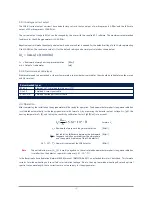
The detector of the Kipp & Zonen SGR series pyrgeometer is based on a passive thermal sensing element called a thermopile.
Although the detector construction differs from model to model, the fundamental working principle is applicable to all SGR series
radiometers.
The thermopile responds to the total power absorbed by the black surface coating, which is a nonspectrally selective paint, and warm
up. The heat generated flows through a thermal resistance to the heat-sink (the pyrgeometer body). The temperature difference
across the thermal resistance of the detector is converted into a voltage as a linear function of the absorbed long-wave irradiance.
The rise of temperature is easily affected by wind, rain and thermal radiation losses to the environment ('cold' sky). Therefore the
detector is shielded by a silicon meniscus window (the entry-level SGR3 has a flat silicon window). To keep the detector and
electronics dry and to prevent condensation forming inside the windows with temperature changes an internal desiccant is used
to absorb humidity within the pyrgeometer.
5.1 Window
The inner surface of the silicon window has an interference filter deposited on it for transmitting the long-wave radiation and
blocking the short-wave solar radiation from reaching the detector. The silicon window material and the deposited ‘solar blind’
filter defines the spectral measurement range of the pyrgeometer.
The silicon window allows transmittance of the atmospheric long-wave radiation up to approximately 42 µm and about 50 to
60% of the radiation spectrum will be transmitted through to the detector. The outer surface of the window has a hard-carbon,
diamond-like layer, deposited as additional protection against environmental influences in harsh environments and to smooth
out the window transmission beyond 30 µm.
The solar blind filter is opaque to radiation below 4.5 µm, known as the cut-on wavelength. Currently most pyrgeometers have
their cut-on at a lower wavelength. Problems may occur in the case of clear sunny days with low humidity. In the solar spectrum
between 2.5 and 4.5 µm there can still be an amount of infrared solar radiation up to 10 W/m², which should not be included in
the measurement. This unwanted fraction is blocked in the SGR4 by the filter coating.
SGR4 uses a specially designed pure silicon window. Although the window is not hemispherical, SGR4 has a 180° field of view
with good cosine response. A big advantage of the meniscus shaped window over the typical hemispherical window is the
ability to deposit more uniform coatings on the window surface. Deposition of a uniform filter coating on a strongly curved
surface is very difficult and unpredictable process. To avoid these problems Kipp & Zonen developed a window with excellent
optical quality due to the optimised shape and coating uniformity.
The solar radiation absorbed by the window is conducted away very effectively by a unique construction in the SGR4. Even in
full sunlight the window heating effect is very low compared to that of other pyrgeometers on the market. This allows accurate
daytime measurements without the need for a shading disk. It also eliminates the need for window heating compensation by
using the correction formula and window temperature sensors.
5.2 Detector
The thermopile sensing element is made up of a large number of thermocouple junction pairs connected electrically in series. The
absorption of thermal radiation by one of the thermocouple junctions, called the active (or ‘hot’) junction, increases its temperature.
The differential temperature between the active junction and a reference (‘cold’) junction kept at a fixed temperature produces an
electromotive force directly proportional to the differential temperature created. This is a thermoelectric effect. The sensitivity of a
pyrgeometer depends on the individual physical properties of the thermopile and construction. The sensitivity of each thermopile
is unique and therefore each radiometer has unique calibration factor, even with the same radiometer model.
5. Principle components of pyrgeometers
27






























